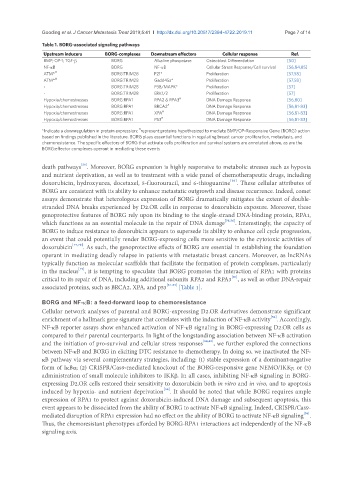Page 316 - Read Online
P. 316
Gooding et al. J Cancer Metastasis Treat 2019;5:41 I http://dx.doi.org/10.20517/2394-4722.2019.11 Page 7 of 14
Table 1. BORG-associated signaling pathways
Upstream inducers BORG-complexes Downstream effectors Cellular response Ref.
BMP; OP-1; TGF-b BORG Alkaline phospatase Osteoblast Differentiation [50]
NF-kB BORG NF-kB Cellular Stress Response/Cell survival [56,84,85]
ATM* ,# BORG:TRIM28 P21* Proliferation [57,58]
ATM* ,# BORG:TRIM28 Gadd45a* Proliferation [57,58]
- BORG:TRIM28 P38/MAPK* Proliferation [57]
- BORG:TRIM28 ERK1/2 Proliferation [57]
Hypoxia/chemostresses BORG:RPA1 RPA2 & RPA3 # DNA Damage Response [56,80]
Hypoxia/chemostresses BORG:RPA1 BRCA2 # DNA Damage Response [56,81-83]
Hypoxia/chemostresses BORG:RPA1 XPA # DNA Damage Response [56,81-83]
Hypoxia/chemostresses BORG:RPA1 P53 # DNA Damage Response [56,81-83]
#
*Indicate a downregulation in protein expression; represent proteins hypothesized to mediate BMP/OP-Responsive Gene (BORG) action
based on findings published in the literature. BORG plays essential functions in regulating breast cancer proliferation, metastasis, and
chemoresistance. The specific effectors of BORG that activate cells proliferation and survival systems are annotated above, as are the
BORG:effector complexes operant in mediating these events
death pathways . Moreover, BORG expression is highly responsive to metabolic stresses such as hypoxia
[56]
and nutrient deprivation, as well as to treatment with a wide panel of chemotherapeutic drugs, including
[56]
doxorubicin, hydroxyurea, docetaxel, 5-fluorouracil, and 6-thioguanine . These cellular attributes of
BORG are consistent with its ability to enhance metastatic outgrowth and disease recurrence. Indeed, comet
assays demonstrate that heterologous expression of BORG dramatically mitigates the extent of double-
stranded DNA breaks experienced by D2.OR cells in response to doxorubicin exposure. Moreover, these
genoprotective features of BORG rely upon its binding to the single-strand DNA-binding protein, RPA1,
which functions as an essential molecule in the repair of DNA damage [75,76] . Interestingly, the capacity of
BORG to induce resistance to doxorubicin appears to supersede its ability to enhance cell cycle progression,
an event that could potentially render BORG-expressing cells more sensitive to the cytotoxic activities of
doxorubicin [77,78] . As such, the genoprotective effects of BORG are essential in establishing the foundation
operant in mediating deadly relapse in patients with metastatic breast cancers. Moreover, as lncRNAs
typically function as molecular scaffolds that facilitate the formation of protein complexes, particularly
[79]
in the nucleus , it is tempting to speculate that BORG promotes the interaction of RPA1 with proteins
critical to its repair of DNA, including additional subunits RPA2 and RPA3 , as well as other DNA-repair
[80]
associated proteins, such as BRCA2, XPA, and p53 [81-83] [Table 1].
BORG and NF-kB: a feed-forward loop to chemoresistance
Cellular network analyses of parental and BORG-expressing D2.OR derivatives demonstrate significant
[56]
enrichment of a hallmark gene signature that correlates with the induction of NF-kB activity . Accordingly,
NF-kB reporter assays show enhanced activation of NF-kB signaling in BORG-expressing D2.OR cells as
compared to their parental counterparts. In light of the longstanding association between NF-kB activation
and the initiation of pro-survival and cellular stress responses [84,85] , we further explored the connections
between NF-kB and BORG in eliciting DTC resistance to chemotherapy. In doing so, we inactivated the NF-
kB pathway via several complementary strategies, including: (1) stable expression of a dominant-negative
form of IkBa; (2) CRISPR/Cas9-mediated knockout of the BORG-responsive gene NEMO/IKKg; or (3)
administration of small molecule inhibitors to IKKb. In all cases, inhibiting NF-kB signaling in BORG-
expressing D2.OR cells restored their sensitivity to doxorubicin both in vitro and in vivo, and to apoptosis
[56]
induced by hypoxia- and nutrient deprivation . It should be noted that while BORG requires ample
expression of RPA1 to protect against doxorubicin-induced DNA damage and subsequent apoptosis, this
event appears to be dissociated from the ability of BORG to activate NF-kB signaling. Indeed, CRISPR/Cas9-
[56]
mediated disruption of RPA1 expression had no effect on the ability of BORG to activate NF-kB signaling .
Thus, the chemoresistant phenotypes afforded by BORG-RPA1 interactions act independently of the NF-kB
signaling axis.

